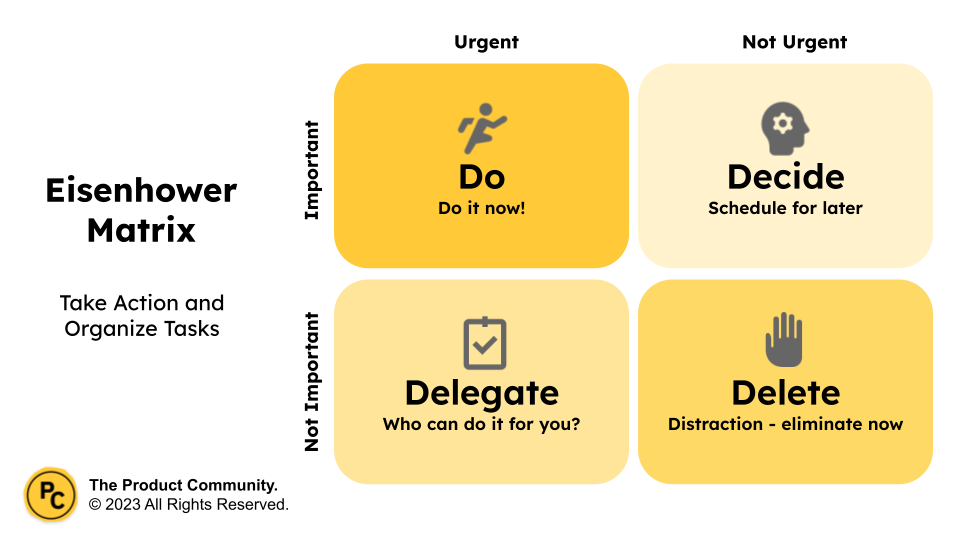Summary
“Innovation is a byproduct of empathy. Winning ideas are a byproduct of taking risks. Excellence is a byproduct of empowered cultures. Profits are the byproduct of happy customers. Success is a byproduct of mattering.”
Bernadette Jiwa
Meaningful: The Story of Ideas that Fly
This is an article on how to prioritize good ideas in the world of associations.
Associations are unique. We are volunteer-led, membership-based, and rely on committees, volunteers, dialogue, and consensus to get work done. Resources are often finite and staff is stretched.
But we’re never short on ideas; there are always new ideas. How do we know which ones are good? As I argued in an article I wrote on leverage, a product framework helps us identify and leverage underutilized value (content, events, programs, etc.) in order to extend its original intention.
This article will focus on how to prioritize ideas in order to green light the ones with the best chance of success.
The product community is a product development learning community designed specifically for associations.
The Case for Prioritization
“You cannot be everything to everyone.”
Jeroen De Flander
“If you chase two rabbits, both will escape.”
Unknown
How does an association distinguish between opportunities and distractions?
While some associations are all things to all people (a sure recipe for frustration and limited growth), others tamp down idea flow so innovation slows to a standstill (a recipe for stagnant engagement and blunted momentum).
Somewhere in between these polars is the strategically-focused association (if, of course, the association has invested in, committed to, and follows through on its strategy and has a unique value proposition).
I argue that focused associations are growth associations. Focused associations invest in strategy, make choices, and develop and stick to priorities.
A prioritization framework is a tool to help us make a decision. It’s not enough to just make a decision; we need to make the right decision.
If your association can work on only a few initiatives simultaneously, how will you decide what to prioritize? We shouldn’t choose initiatives at random or prioritize the demands of the strongest voice.
We should prioritize initiatives that support an association-wide objective based on agreed-upon criteria. These three elements suggest that all associations need a prioritization framework:
Initiatives (ideas, requests, mandates, etc.)
Limitations (budget, capacity, capability, time, etc.)
Outcomes (revenue, engagement, growth, etc)
Effective prioritization leads to an effective roadmap, which in turn translates into three incredible things for our associations: time savings, clarity and focus, and consistent, measurable outcomes. Moreover, prioritization helps us:
Achieve strategic focus
Avoid shiny objects syndrome
Improve transparency
Build trust
Use common prioritization criteria
Stop being all things to all people
Together, these ingredients will result in deeper and wider impact, sustained growth, enhanced engagement, greater connection. I also argue we’ll vastly improve our relationships with our governance bodies (board, committees, task forces, etc.).
How does it work?
Four Prioritization Frameworks
“When everything is a priority, nothing is a priority.”
Karen Martin
Not all good ideas are good ideas. Some are better fits; others are easier to execute. What might be a good idea for one association might bomb at another.
There are, however, many ways to prioritize ideas. These frameworks can also be used for your existing offerings (though we cover how to analyze offerings and/or product portfolio in a future article).
Here are four of the more common prioritization frameworks (If you’re interested, here is a list of others).
Eisenhower Matrix: The Eisenhower Matrix is a prioritization framework that helps us to determine which tasks we should focus on first. It consists of four quadrants, where we categorize our tasks based on their level of importance and urgency. The top-left quadrant contains important and urgent tasks that require immediate attention, while the bottom-right quadrant consists of tasks that are neither important nor urgent, and can be postponed or eliminated.
MoSCoW Method: The MoSCoW Method is a prioritization technique that helps us prioritize requirements or tasks based on their level of importance. It involves categorizing requirements into four groups: Must-Have, Should-Have, Could-Have, and Won't-Have. The Must-Have items are essential and must be delivered, while the Should-Have and Could-Have items are important but can be postponed if necessary. The Won't-Have items are low priority and can be dropped altogether.
Value Complexity Quadrant: The Value Complexity Quadrant is a framework that helps us prioritize tasks based on their value and complexity. It involves breaking down a project into smaller, manageable tasks and prioritizing them based on their importance, estimated effort, and potential impact. The aim is to focus on the tasks that will deliver the most value with the least effort, while also considering the risks and dependencies involved. The prioritization is usually done in a collaborative way, with the input of the team members and stakeholders.
Rice Scoring Model: The Rice Scoring Model is a prioritization framework used to evaluate and rank potential projects or initiatives based on their expected impact and feasibility. It assigns scores to each project based on several criteria such as the potential benefits, resources required, and risk involved. The higher the score, the higher the priority for the project. In simpler terms, the Rice Scoring Model is a way to decide which projects are most important to focus on based on how much they will help and how feasible they are to complete. It's like making a to-do list and deciding which tasks are the most important and achievable based on their value and the effort required to complete them.
Prioritization is the disciplined process of evaluating the relative importance of work, ideas, and requests to eliminate wasteful practices and deliver member value in the quickest possible way.
The reality of evaluating ideas and building products is that you can never get everything done — priorities shift, resources are reallocated, funding is scarce. As association leaders, it’s our job to make sure we’re working on the most important things.
Shared Vision + Healthy Culture = Focused Growth
“Ideas never stand alone. For most, there is no singular magical moment; instead, there are many small insights accumulated over time.”
Scott Berkun
The Myths of Innovation
To achieve focused growth, I always recommend developing a robust shared vision which (if properly devised and implemented) should help contribute to a healthy culture. Shared vision plus healthy culture are two central ingredients to focused, diversified growth. It’s how we create and sustain thriving associations.
Three final thoughts on the importance of prioritization.
Prioritize ruthlessly – What matters in your association? The value and the process whereby we answer this question should be an exercise in decorum, action, and transparency. Small things like making your priorities clear, visible, and communicated make our associations more consistent and, over time, more focused and more innovative.
Be the tortoise, not the hare – Set aspirations high but be methodical in the way we go about achieving them. As the Aesop’s Fable goes, slow, steady, consistent, and incremental wins the race. Always keep the big picture in mind, but don’t let it suffocate you. Break it into achievable goals with realistic timeframes. Insist on accountability. Then knock the goals off, one by one.
Put the squeeze on distractions – Distractions, in a highly distractible world, are our biggest threat. Screens, social media rabbit holes, the urge to do something new, shiny objects, random ideas. There is a lot of competition for our already scattered attention. If we can’t master our distractions, they will master us.
Product-led growth fuels connection. Join the product community and flip your destiny.
About the Author
James Young is founder and chief learning officer of the product community®. Jim is an engaging trainer and leading thinker in the worlds of associations, learning communities, and product development. Prior to starting the product community®, Jim served as Chief Learning Officer at both the American College of Chest Physicians and the Society of College and University Planning.
Please contact me for a conversation: james@productcommunity.us.









